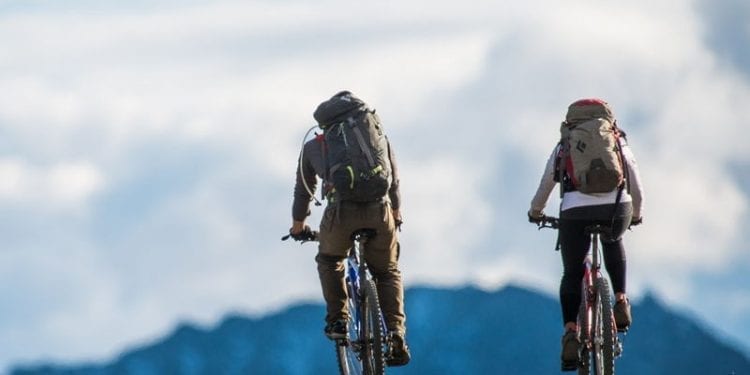Rent a bike and experience a new country in one of the most rewarding ways. Get a perspective that’s unachievable from a car seat. Immerse yourself in your surroundings, take time to fully appreciate the scenery, and breathe the fresh air… experience the world’s best cycling tours.
You don’t need to be experienced or incredibly fit to go on a bike tour. You don’t need to invest in spandex and shave your legs to become more aerodynamic. You have no obligation to spend your rest stops refueling on energy gel. Travel as far as you’re comfortable doing. During rest stop, feel free to have a beer and eat a sandwich. In fact, a cycling tour is the perfect way to eat and drink your fill without worrying about putting on weight.
Thanks to modern technology, you can even opt for electric-assist bikes. Turn on the electric motor when you’re heading up a steep hill to make things a bit easier.
France
Home to the world’s most famous cycling race, the Tour de France, fine cycling routes are abundant. Most take you close to vineyards providing easy access to French food.
The best season to tour France on bike is between May and September, although the weather can get very hot in August. Even then, the lack of humidity means you won’t get too uncomfortable.
Everywhere in this country is suitable for bikes, even outside the cities. Cyclists are a common sight on French roads.
The French Alps offer steep climbs and spectacular views. There are enough flats for it to be accessible to amateurs and for anyone looking to have a more serene ride. Country roads are quiet, and the unpolluted mountain air is as pure as the snow on mountain peaks.
The Loire Valley is home to many of France’s grandest castles. The gentle, flat countryside makes for very easy riding.
The Loire à Vélo, an 800 km cycle route, takes you to the Valley of the Kings, a UNESCO World Heritage Site. You’ll find plenty of spots for food and drinks in small towns and villages when riding alongside the river bank.
Italy
The countryside, architecture, food, and drinks make it appealing to both committed and occasional cyclists. This is the perfect way to take in Italy during the summer.
With rolling hills, historic towns, and cypress trees, Tuscany is a favorite. You’ll get a real feel of the land with vineyards, olive groves, wheat fields, and old stone farm houses. Let new views across the countryside during each climb be your reward.
From summits, you can attempt to measure if the town you’re heading for appears any closer. Refuel and keep your spirits high with wine, bread, and local meats and cheese.
Abruzzo is famous for craggy mountains with steep climbs and white-knuckle descents. However, a new initiative from the town of Montesilvano is changing this perception.
The council has restored an old railway line and turned it into a cycle path through the region.
The trail covers 20 kms through parts of Abruzzo you might not otherwise visit, allowing you to experience some of this regions authentic countryside. The bike path feeds onto the Adriatic route, one of the regions finest.
Join us January 8. for our annual global index reveal.
India
Most people choose to bike between major cities here. Your first task is to select your arrival and departure destinations. Outside of major cities, you will find very few tourists but plenty of interested locals. As a westerner in a remote part of India, you will almost certainly be the center of attention. Though a bit intimidating, it’s a great chance to interact with locals and create memories.
There are parts where it’s not safe to travel after dark, like the regions of Chhattisgarh and Jharkhand. Many report India is perfectly safe during the day, nonetheless do your own research and don’t travel anywhere you feel uncomfortable. Accommodation and food are easy to come by and very affordable.
A special bike path or bicycle highway between Agra and Etawah has been completed. The trail is over 200 kms of winding countryside, paved for easy traverse, and completely free of cars. The end of the trail, Etawah, is home to the Taj Mahal. This path has the potential to be a big tourist draw.
Turkey
Big cities in Turkey are not bike-friendly. If you have to bike out from one, be careful and don’t expect any favors from others. The roads can be rough, so make sure you’re supplied with appropriate tires and a puncture repair kit.
This is not the easiest country for cyclists. You will find that they do not always have proper road signs. Even GPS can be hit and miss. Areas by the coast are mountainous while the interior of the country is mostly hilly. The east of Turkey can be wild in places, so make sure you research your route before you leave.
Read a few cycling blogs and you will soon discover that locals are welcoming and friendly. People will stop to chat with you, invite you into their homes for food and drink, and offer you a room for the night. There are plenty of safe and pleasant places to camp in the countryside. However, if a passing local spots your tent, they may insist you stay with them. If you’re dead set on camping, put your tent somewhere out of the way.
Mexico
First thing’s first, Mexico is safe. You don’t have to worry about kidnapping, mugging, or cartels. The dangers are the same as in the United States.
There are a few popular routes to take when cycling in Mexico. One starts at the American border in Baja California, bike down to La Paz and then get the ferry across to Mazatlan. This coastal route is generally at lower altitude and fairly flat. When possible, aim to take the toll roads as these have the least amount of traffic. Toll roads can be recognized by the letter D at the end of the name, e.g. Fed. 1D, Fed. 2D, etc.
Another route starts in Mexico City from where you cycle to Oaxaca. From there, through to the Pacific coast, follow down to the border with Guatemala. To visit the Caribbean coast, head east from Mexico City toward Xalapa. From Xalapa, ride on to Veracruz.
Mexico is vulnerable to hurricanes, especially between August and October. Plan ahead and try to avoid booking your tour during these months.
A heads up on Mexico City: The traffic is atrocious. Under no circumstances try to cycle anywhere during rush hour. If you can, try to leave on a Sunday when the roads are quietest.
Vietnam
Cycling in Vietnam is a world away from the more established routes. Terrains include dense jungle, misty mountains, and vast stretches of empty beaches. There are also miles and miles of rice paddy fields. Yes, Vietnam deserves its place on any list of the world’s best cycling tours.
This is a safe and welcoming country. You will have no trouble finding delicious food at the end of the day’s excursions. You’re likely to be an object of some interest to locals. In Vietnam, people cycle for purely practical reasons. The most common response you will get to your explanation of cycling vast distances for pleasure is bemused laughter.
Accommodation is cheap. You won’t pay more than US$15 for a basic room. Food is also inexpensive.
The most popular route is the Ho Chi Minh trail, connecting the North and South of the country. If you’re planning to bike the complete trail, you will need to set aside at least a month.
Many people choose the route with the most tourist attractions and best scenery. Take a bus to shuttle you through the less interesting parts.
Cyclists are common in Vietnam, and drivers are used to looking out for them. There are plenty of people with practical experience who can lend a hand if something goes wrong with your bike. Spare parts are easy to come by, although you might need to make do with cheap parts if you have problems outside one of the major cities.
Spain
Spain is used by many professionals as a warm-weather training location for the winter months. It’s a country that has everything a cyclist could wish for: paths, great food and drinks, and different terrains to keep things interesting.
As well as the famous Pyrenees mountain range, you have the chance to cycle through the serene calm of Europe’s only desert.
Piece of advice, do not plan your cycling tour to Spain between the months of June and September when the heat is at its peak.
Some routes here have become favorites with cyclists. Disused railway lines covering much of Spain—7,600 kms—known as the Vias Verdes (green ways) have been restored by cyclists, walkers, and horse riders. These offer an opportunity to see parts of Spain that are off the beaten track. It’s also a very safe way to cycle around this country, off-road, away from cars and traffic.
Indonesia
Indonesia has wonderful, quiet roads ideal for cyclists. Most places outside big towns are peaceful and safe. These routes aren’t for the faint-hearted, though.
The country is made up of volcanic islands, so you’ll encounter lots of steep climbs. However, the rewards are worth it. Experience spectacular views, fresh fruits, and welcoming locals keen to help with whatever they can.
Traffic varies from island to island. Java is heavily populated and has narrow roads, so expect lots of traffic, including trucks. Bali is quieter, with well-maintained roads, and plenty of places to stay. The capital city, Denpasar, is full of chaotic traffic that can make cycling an unnerving experience.
Roads are quieter on the smaller islands and you can go long stretches without seeing a car. When passing through the small villages, locals will be pleased and interested to see you. Accommodation and food can be hard to come by, so plan ahead by carrying some supplies and map out a route of places to sleep.
Portugal
Portugal is a great place to cycle. The North of Portugal offers warm weather without being oppressively hot during the summer. Days are long with plenty of sunshine. The south is far too hot during these months, though.
The best time to visit the Algarve (and the south) is during the spring and fall. The winter is also mild and comfortable for cycling, although there are more rainy days. Even so, southern Portugal is one of the premiere places for winter cycling in Europe.
You can find plenty of accommodation, and the local cuisine is inexpensive and delicious. There’s plenty of architecture to take in, and coastal routes take you past many of the best beaches in Europe.
The areas around the coast are fairly flat but inland cycling is not easygoing. There are lots of hills and valleys. If you are hoping to get some miles on the clock each day, you can expect to work hard.











